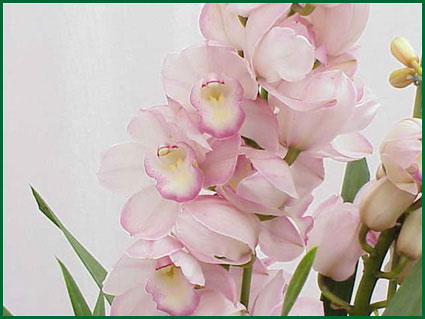
Cymbidium Flower
Light:
Cymbidiums need high light, but direct light could burn the plant.
If the foliage on the plant is dark green and limp, it is an indication the plant needs more light. Ideally, the foliage should be a medium green to yellowish green color.
Temperature:
Cymbidiums need bright light, but cool temperatures, especially to promote blooming.
Cymbidiums prefer night time temperatures between 50-60°F and 75-85°F during the day.
In winter months, the ideal temperatures are 45-55°F at night and 65-75°F during the days.
It is very important that temperatures are consistent during blooming to prevent bud drop.
Water:
Cymbidiums need to be watered consistently during the spring and summer months. During the winter months watering should be reduced.
The best way to water Cymbidiums is to remove them from their decorative pots and flush them with water for 1 to 2 minutes under a faucet. If that is not possible, you can also place 5 or so ice cubes on the bark once a week.
Humidity:
During the summer months the ideal humidity level is 70% humidity. In winter 40-60% humidity is adequate.
It is important to keep air circulating around the plant to prevent fungus.
Feeding:
During the growing season Cymbidiums need a fertilizer than is high in nitrogen like 30-10-10 or a ratio that is similar.
In winter, it is recommended to fertilize once per month, but only after watering to avoid burning.
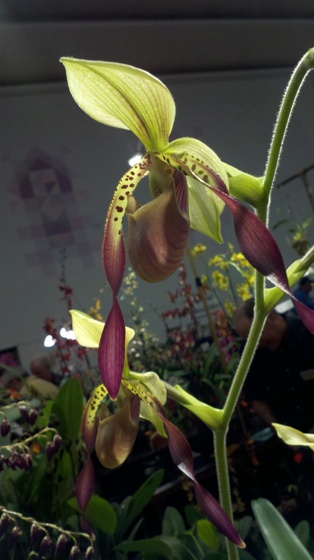
Masdevallia flower has a very showy part the sepals: genus the tiny petals nestled in the center structures of the flower. Joined at the base sepals narrow toward the tips, long tails in some species resemble kites. Triangular or tubular flowers are of the usual form. Colors of flowers include pure white, brownish black and green. Most popular species are red and orange. Sizes of Masdevallia range from 1 inch to 10 inches. They may be erect or pendent. Masdevallia requiring constant moisture are true cloud forest orchids. Tiny stems sprouting small rhizomes have no pseudo bulbs; fleshy leaves are borne and cannot go periods without water. Masdevallia need lots of humidity, few species will grow in intermediate temperatures. Excess water on the plant may cause fungus infection that rots the leaves that join the stern.
Light: Masdevallia grow in shade areas in the forest. Cultivation, about 1,000 to 1,400 foot candles of light is adequate. Leaf color should be medium to light green. Yellow leaves mean too much light.
Water: Masdevallia plants are potted up small and are necessary to water often. Depending on the time of year, container and medium ranging two to three times a week in the summer to about once a week in the winter, medium should stay moist not sopping wet. Water pots thoroughly to ensure moist soil. Over watering will not make up for lack of humidify and could cause root rot.
Feeding: Masdevallia not heavy feeders, balanced fertilizer should be applied half strength once or twice a month. Leaf tip burn is caused by overfeeding.
Provide 20-20-20 orchid food.
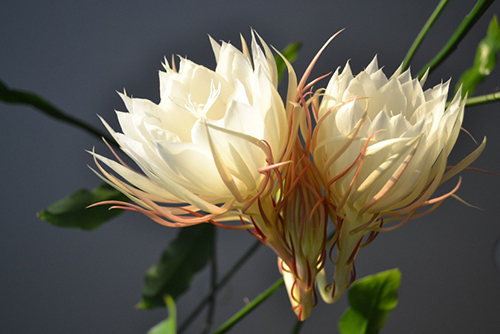
Night Blooming Orchid
Orchid Cacti that blooms usually in the summer. The flower buds begin to open around five in the evening and bloom through the night lasting only until sunrise.
Has a fragrance that is spicy-sweet and is very strong in small areas. A very beautiful flower that quickly goes limp after blooming.
Easy to grow indoors with good light and outdoors in mild climates. Mostly treated like an Orchid when comes to water and fertilizer.
Cuttings may be taken and placed directly in soil for starting a new plant. Roots quickly in cactus mix. My experience takes about three years for first bloom from cutting.
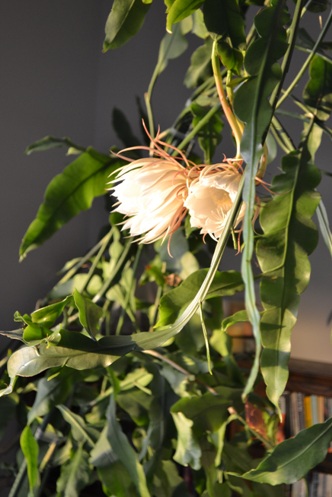
Night Blooming Orchid June
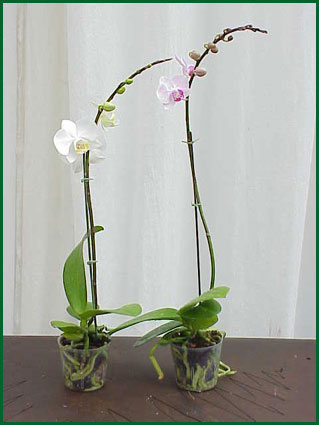
Phalaenopsis
Light:
Phalaenopsis orchids can survive in low light to moderate light situations. However, if exposed to direct sunlight, the leaves will suffer sunburn and become unsightly with black splotches.
Phalaenopsis do best in an east or (shaded) west facing window, but make sure that the plant is at least about 3 feet away from the glass.
If the foliage on the plant is dark green and limp, it is an indication the plant needs more light. Yellowish leaves indicate the plant is getting too much light. Ideally, the foliage should be a bright olive green.
Temperature:
Ideally, Phalaenopsis prefer night time temperatures between 60-65°F and 70-85°F during the day. However, Phalaenopsis are fairly tough in the sense that they can take temperatures in the mid 50’s up to 95°F temperature. If the temperatures do get little high, one should increase the humidity, water and air circulation around the plant to compensate.
If possible, try to avoid temperature fluctuations, as this may cause closed buds to drop.
Water:
Phalaenopsis orchids do best when only watered when the potting media has almost completely dried out. Depending on the environmental conditions that could be as much as twice a week in the summer and as little as once a week during the winter months. Ideally, Phalaenopsis should be watered early in the day to prevent moisture from setting on the plant overnight, as it could lead to root rot, crown rot and other diseases.
The best way to water Phalaenopsis is to remove them from their decorative pots and flush them with water for 1 to 2 minutes under a faucet. If that is not possible, you can also place 5 or so ice cubes on the bark once a week.
Humidity:
The ideal humidity conditions for Phalaenopsis is between 50% and 80% humidity. In warmer and drier conditions, Phalaenopsis can be placed on gravel that has water in the bottom to elevate the local humidity. However, you should never let the pots sit in water as this will cause root rot.
On days of high humidity make sure there is good air circulation around the plants.
Feeding:
In general, Phalaenopsis do best and are at their healthiest when fertilized on a regular basis. Once a month is ideal. Use a well balanced formulation such as 30-10-10 or a smaller ratio.
Important that the plants are slightly moist before fertilizing to avoid burning.
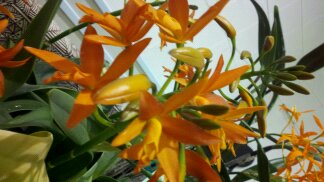
Dendrobium Nobile
Water: In the spring when the temperatures begin to rise, gradually start watering. When temperatures are high and sunlight is strong, water almost every day to keep the plant from dehydrating in the greenhouse and once a week in the house.
Water the plant enough to moisten the surface of the medium once every five to seven days during the warmest part of the day. Medium should dry before evening.
Light: Small plants require no shade during the winter. 30-40 percent shade is needed from late spring through autumn for healthy growth. Medium flowering size plants do not need shade any time unless leaves begin to burn. Full sun promotes vigorous growth.
Temperature: To determine the flower bud it is important to expose plants to low temperatures. Flower buds which grow from spring through summer and mature in the
Autumn require approximately one month of low night temperatures. Autumn when it becomes cool, do not rush o bring plants into the greenhouse, unless a freeze is forecast. Leave them outside to cool and they will bloom better.
When in full bloom, flowers will last longer if the plant is placed in a cool, dry spot away from any draft and out of direct sunlight. A night temperature of 40 to 50 F is ideal.
Feeding: Low-nitrogen fertilizer is ideal for flowering specimens. Fertilizing should be discontinued after early August to guarantee more flowers. Small plants where night temperatures fall below 45F in winter; fertilizer should be applied when night temperatures rise to about 50F. Apply fertilizer high in nitrogen when night temperatures rise to 50F March and April. When night temperatures in winter are above 50F fertilize in January. Time-release fertilizers are effective for more than six months which are good for Small plants. Do not use timed-release fertilizers on flowering-size plants; they may cause over fertilization.
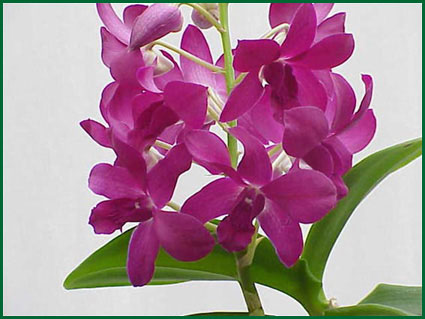
Dendrobium Purple Flower
Light:
Dendrobiums love morning and afternoon sun. However, they should be shaded from intense afternoon heat.
Dendrobiums do best in an east or shaded west facing window.
If the foliage on the plant is dark green, it is an indication the plant needs more light. Yellowish leaves indicate the plant is getting to much light. Ideally, the foliage should be a bright olive green.
Temperature:
Ideally, Dendrobiums need variations of between 15 and 20°F between daytime and night time temperatures. The night time temperatures should be between 60-65°F and 70-90°F during the day. If the temperatures do get little high, one should increase the humidity, water and air circulation around the plant to compensate.
If Dendrobiums are exposed to temperatures below 50°F, there may be some leaf drop.
Water:
Dendrobiums have water storage bulbs and need to dry out between watering. The best way to water Dendrobiums is to remove them from their decorative pots and flush them with water for 1 to 2 minutes under a faucet. If that is not possible, you can also place 5 or so ice cubes on the bark once a week.
Humidity:
Dendrobiums need humidity conditions between 50% and 60% humidity. In warmer and drier conditions, Dendrobiums can be placed on gravel that has water in the bottom to elevate the local humidity. However, you should never let the pots sit in water as this will cause root rot.
On days of high humidity make sure there is good air circulation around the plants.
Feeding:
In general, Dendrobiums do best and are at their healthiest when fertilized on a regular basis. Once a month is ideal.
The growers recommend that you use a well balanced formulation such as 30-10-10 or a ratio that is similar. However, it is important that the plants are slightly moist before fertilizing to avoid burning.
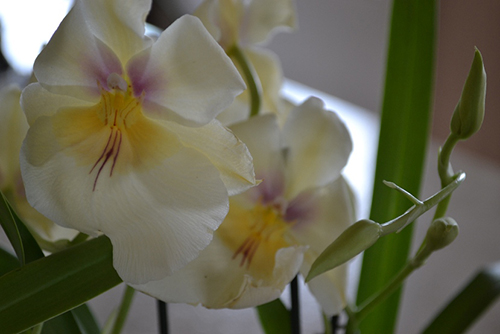
Miltonia
Known as Pansy Orchids, large flat flowers look like genus Viola. Most flowers are lightly fragrant. Part of sub tribe Oncidiinae. Twenty species of Miltonias that are distinguished between their relatives Oncidium and Odontoglossum. When not in bloom the leaves are flat and thin and the bulbs of the Miltonias are hard to tell apart from the related species genera.
Flowers range in colors from white to pink with splotches of magenta.
Light: Requiring light about the same a Phalenopsis Orchid 1,000 to 1,500 foot candles. Cool night temperatures, daytime not over 80F.
Brazilian Miltonias don’t look like the pansy orchid, they are marked with brown, purple and red. Resemble Odontoglossum in shades of yellow and green. They prefer light intensities 1,500 to 3,000 foot candles. Make great cut flowers.
Miltonias sunburn easily. You know when Miltonias get enough light when the leaves are light green. Slightly pink means they have enough light.
FEEDING: Administer 30-10-10 fertilizer ½ teaspoon per gallon of water, weekly in fir bark culture. Pansy orchids are not deciduous should be feed during the winter ¼ teaspoon per gallon when plants need water.
WATER: Miltonias do not withstand long periods of dryness. They prefer the same watering as cymbidiums, keeping them moist but not soggy. Fir bark, sphagnum moss, perlite and charcoal are a good balance. When leaves are pleated, that means not enough water, then when watered more the leaves may look like accordions. The next set of leaves should then be smooth.
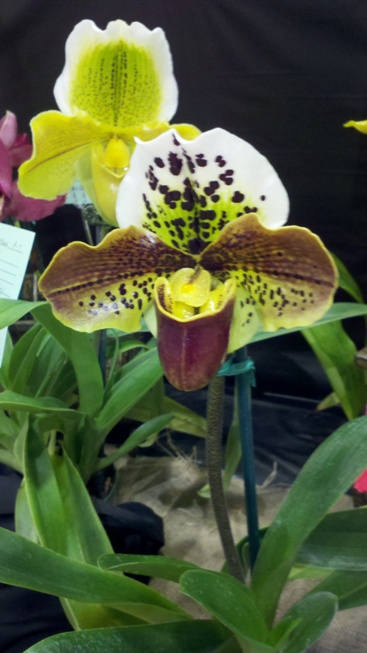
Most orchid appearance and their flowers differ from Paphiopedilum. Features that sets the flowers apart is most obvious the pouch a cup like. Which has the name “lady’s slipper” most common and their relatives the subfamily Cypripedioideae.
Temperature:
Ideally for the green-leaved types require a minimum light temperature SO to SS F, and the mottled-leaved types need 60 to 65 F at night.
Day temperatures should range between 70 F and 80 F; moderately short periods of higher or lower temperatures will injure plants. Moderate. Humidity during the day should be between 40 and 50 degrees.
Light:
Paphiopedilum require medium light 800 to 1,000 foot candles most of the year. Indoor plants should be placed away from the direct sun a place where the sun shines through sheer curtain.
Water:
Paphiopedilum like Phalenopsis prefer a regular and constant water supply. It is good to keep the soil moist and not soggy or wet. Early morning watering will allow the soil to dry by nightfall.
Paphiopedilum depending on the soil conditions would need water every five to seven days. Bark medium would not like to dry out completely, if this happens then whole pot should be submerged in a pan of water until moisture is restored.
Feeding:
Paphiopedilum planted in fir bark require 30-10-20 or 30-10-10 a high nitrogen fertilizer at half the recommended strength. When greenhouse grown fertilize three times that and then fourth time leach out any salts. When growing in the home, alternate fertilizing with plain water. Paphiopedilum grown in leaf mold, peat moss and rock, should be fertilized at a reduced strength.